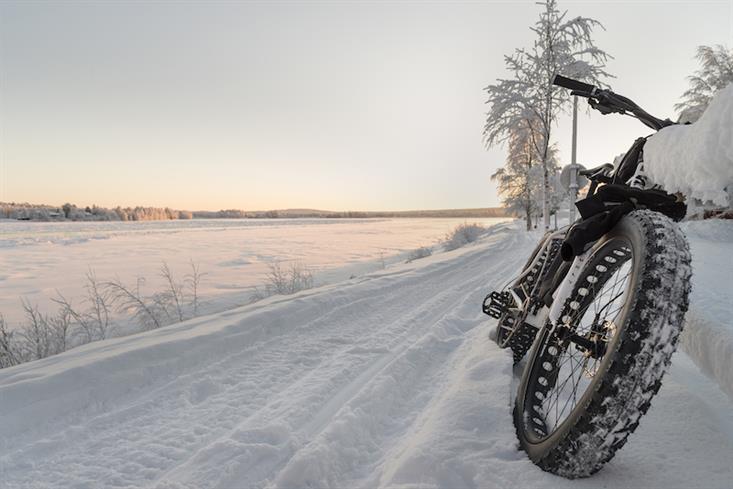
Are you a fan of winter biking? Considering getting into it? Regardless of your experience, you are not alone. It’s a great way to get out of the house while keeping yourself healthy. For the residents of RidgeWood West, the Harte Trail is the perfect place for the winter cyclist looking for everything from a leisurely ride to someone who is looking to set some fitness goals. It’s also a safe route for cyclists wanting to avoid the road.
But how do you stay warm while you’re out riding? Wind can become a real challenge when the temperature is below zero, especially when it gets near -30 degrees Celsius. The Harte Trail has some sections sheltered by trees and forest, but there are some clearings as well, and these can be especially frigid.
Bike maintenance is especially important in the winter as the weather is especially hard on equipment. Things like water, sand, salt, and grit can get stuck in your equipment and cause them to jam up or begin to rust.
With winter biking becoming more popular every year, in Winnipeg, there are lots of different products available to help keep your bike functioning properly and to help you stay warm while you’re out in the cold.
Winter Tires
First and foremost, winter tires are the number one modification required to ride your bike safely in the winter. Winter tires range from knobby to studded. Knobby tires are similar to a mountain bikes tires, but come in every size from fat bike to road bike. The larger protruding bits, or ‘knobs’, allow the tire to puncture the snow and safely propel the bike forward. Studded tires do the same, but their tiny metal protrusions allow the bike to puncture ice as well. These tires can wear significantly in a season, so be sure to have them checked each year.
Mud Guards
Ever notice a cyclist on a rainy day with a soaked backside? Those cyclists didn’t have mud guards. Having mud guards keeps you dry, which is the first step to staying warm. They are arguably the second most important piece of winter gear for your bike. These play an important role in keeping you dry and warm. Due to the physics of a bicycle, snow, slush and water are picked up by the wheels and flung back at you.
Lubrication and Maintenance
Due to the excess sand and grit on the roads, and the fact water can rust metal, keeping your bike’s gears and chain properly cleaned and lubricated is of the utmost importance. If you let the gears and chain rust, your bike may end up needing replacement parts after one season. Another important element of winter bike maintenance are brakes. Making sure your brake pads are working properly means checking your rim for ice, and keeping tabs on the pads as the wear.
Dress in Layers
Dressing in layers is an obvious choice for any winter activity, but it is especially important when cycling. With the bike moving forward and either with or against the wind, you will be experiencing a multiplied wind-chill. With wind-chill calculated by wind speed and temperature, just imagine the effect when you add speed (in this case, on your bicycle). Dressing appropriately will ensure you don’t freeze, but make sure to consult the windchill chart from Icebike.org (it’s in Farenheit, but simple to convert with Google).
Proper Gloves & Face Wear
Just about the only appropriate face covering for winter cycling is the balaclava. Frostbite is your number one enemy when it is especially cold, so covering as much skin as possible is necessary. An alternative to this would be a neck warmer that covers the bottom half of your face, paired with a toque and ski goggles. This provides total coverage, but can be colder on some parts of the faces, namely the eyes and nose. Goggles also prevent eyes watering from exposure to wind. A breathing mask, commonly found on runners, is also a great way to keep your face warm while allowing proper airflow.
Always Carry Tubes & A Pump
If you’re heading out on the Harte Trail with the intention of going for a long trip, bring along a pump and some spare tubes. If you pop a tire while it’s 30 below and you’re in the middle of a field, or just several kilometers down the trail, the last thing you want to do is have to walk back home with the bike and its flat tire.
Mobile Phone
Almost a no-brainer; always bring your mobile phone. Since you’ll be out on the trails on your bike, make sure you have a high impact case in case of a wipe out. Bringing your phone with you is important as it provides a lifeline in the case you injure yourself, but in addition to safety, you can also make use of lots of great apps to improve your journey. There are GPS and mapping apps to record your trip and keep you up on your exact whereabouts. Some apps provide heart rate monitoring, fitness diaries, and more, and finally, make sure you take lots of pictures. Instagram is a great place to put enticing photos of your fun, and if you take good photos, you might even be able to get some friends to join you next time.